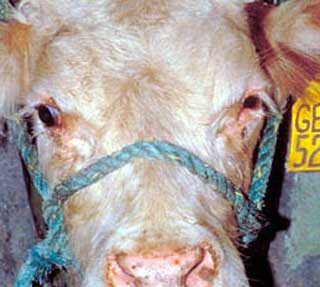
Causative Agent:
IBR is caused by the bovine herpes virus -1. This virus can be responsible for respiratory as well as abortion problems.Clinical Signs: Fever, decreased appetite and milk production, increased salivation, coughing, and nasal discharge are often some of the first symptoms. As the disease continues, the animal may develop signs such as difficulty breathing, teary, inflamed eyes (conjunctivitis), and a "red nose" with pustules. These signs can also be associated with abortions occurring up to 100 days after the respiratory signs appear.

Disease Transmission: This virus is transmitted from infected to non-infected animals by direct contact with body fluids or contaminated equipment (halters, troughs, feeders, etc.). Stressful events and situations where large numbers of animals are kept in close confinement may increase the chances of disease.
Diagnosis: Some cases of IBR can be identified by the clinical signs and initial physical exam. Exposure to this virus can be determined by sending in a blood sample from a suspect animal. A blood sample should be collected in a red top blood tube and sent to the appropriate laboratory as soon as it is collected. It is usually necessary to take a second sample 2-3 weeks after the first and send it in to the same laboratory for testing. Necropsy findings from both fetal and adult animals may also be beneficial in diagnosing this disease.
Treatment: An animal with a viral respiratory infection should receive supportive care and potentially antibiotics (Nuflor, Naxcel) to prevent secondary bacterial infections. Supportive care involves fluids, shelter, and an anti-inflammatory drug (Banamine).
Prevention: Vaccination (with a booster 2-4 weeks after the first vaccination) at least 2 weeks prior to a stressful event or potential exposure is the best prevention. Annual vaccination is recommended thereafter. Isolating any new animals for 2-3 weeks before they are introduced to the rest of the herd is also recommended. Any animal that has a respiratory infection should be isolated from the rest of the herd to prevent disease transmission.